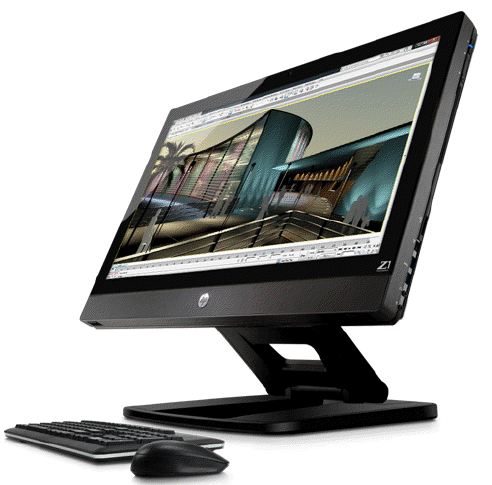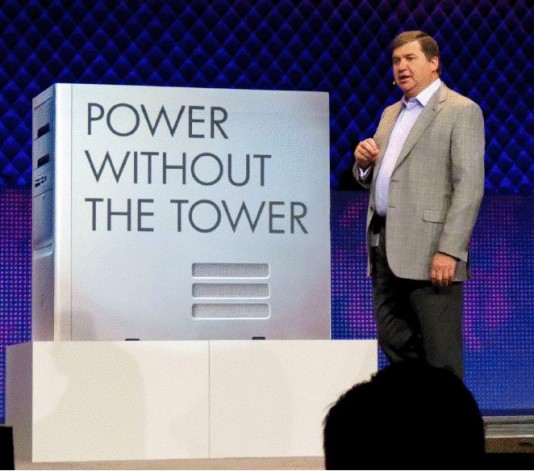With simultaneous public roll-outs in Las Vegas and San Diego, HP re-asserts itself as the dominate player in workstations with a novel new product.
HP is putting on a big show in Vegas. The company is repositioning from the ground to the cloud, and it is reminding the world that it is Number 1. The numbers have always been there but a year of chaos and two CEOs have tarnished the once steady company’s reputation. HP has been teasing folks about the new announcements coming with their partner conference held in Las Vegas. The company is clearly excited and newly committed to its PSG (Personal Solutions Group). That’s the group Leo Apotheker thought he might sell and not only did the troops inside HP rebel, but so did the customers. Heck, even HP’s competitors balked. At this partner convention, the message was clearly in support of the computer group as well as the printer group. And, in fact HP boldly built the opening day show around workstations. Yes, that’s right workstations.

During the opening keynote, PSG chief Todd Bradley, along with Jeff Wood VP of Marketing for workstations and Jim Zafarano VP and GM for commercial solutions workstations, showed off workstations in the Z line, including their big behemoth top of the line Z800, which, Jeff Wood said, configured the way it should be configured, designed for the jobs it should be doing, would be priced at about $80,000. “How many of you want to sell an $80,000 workstation?” He asked the crowd. And he opened up the chassis of a big workstation and pulled out a cute little baby workstation, the Z210. Wood said that customers in Asia and in markets where there are size and price constraints were asking for smaller and more affordable workstations. HP says the Z line has been well received and has helped the company maintain its number one position in the workstation market. But that’s not what they came to tell us.
Zafarano and Wood had an even bigger surprise in store for the world. They walked over to the big mysterious box that promised “Power Without the Tower,” and lifted it to reveal the Z1 workstation, an all-in-one unlike any other all-in-one. Two years in design and development, the Z1 is an engineering marvel. The screen can fold back and lie flat. It ships that way, and that’s the way you open it up and get inside to service it. Just like the other workstations in HP’s popular Z line, the Z1 has snap-in components that can be easily removed and replaced or upgraded. And we thought “Power Without the Tower” was going to be some cloud thing.
The base machine will ship for $1899. It is equipped with a Xeon processor with integrated graphics. Moving up the scale, HP has worked with Nvidia to create a special graphics product for the Z1. Rather than use a standard graphics board for a PC or workstation, they started with a mobile MXM GPU module rather than a standard graphics card design, then HP invented a custom blower and housing for the GPU, which snaps in and out of the Z1. Nvidia builds its own Quadro boards, and Nvidia GM Jeff Brown says that Nvidia built the boards for the Z1. Brown was on hand to help celebrate the unveiling of the HP boards. He told the audience at a presentation for press and analysts that the full Quadro line of graphics will be available as Z1 options. When the Z1 ships later this spring, the different graphics options will be available as options when the Z1 is purchased. The boards will be available as after-market products sometime later in the year.
HP and Nvidia said pricing is still being worked out. There are more details to come. HP is thrilled with the design they came up with that combines the requirements of a workstation—reliability, serviceability, rugged design, scalability—with the compact style of the all-in-one, and the design runs cool and quiet thanks to a system of air channeling and specially designed fans. HP was a little short on specs for now. More details will be coming along but the basics are this: 27-inch IPS display 2560×40, with over a billion colors; Xeon Core i3 2120/HD 2000 graphics for the base system, scales to quad-core Xeon E3-1245 or E3-1280; Nvidia Quadro Graphics options; various HDD options including SSD, RAID support. HP has also designed a Display Port that supports both input and output. The Z1 can support a secondary monitor mounted side by side using a heavy duty VESA mount.

HP sees broad opportunity for this new computer in all segments of the workstation market. However their prime targets at the rollout were CAD and media and entertainment. HP’s unveiling was going on at the same time as SolidWorks World. Autodesk’s Chris Bradshaw came to Las Vegas to express Autodesk’s support for HP’s design. Bradshaw said that the earliest adopters for the new monitor will come from small businesses that place a premium on design and size. He was backed up by Nvidia’s Greg Estes, executive for media and entertainment, who pointed out that most FX houses are small companies with people working in close quarters who collaborate. They need quiet machines. Also, these machines will make sense in broadcast suites and on-set situations.
What do we think?
The all-in-one is a great design and it’s only natural it be extended to the workstation class. However, HP has not done it by thinking small, by redefining the workstation. Rather, they have redefined the all-in-one. In the process, they have the potential to expand the market for workstations. There is an even bigger story for HP as the company defies conventional wisdom about the PC industry. Todd Bradley told the audience, “we’re going to continue the momentum and kick ass.” The Z1 demonstrates that the company plans to do it by building on HP’s legacy of engineering and quality and not by battling on price.





